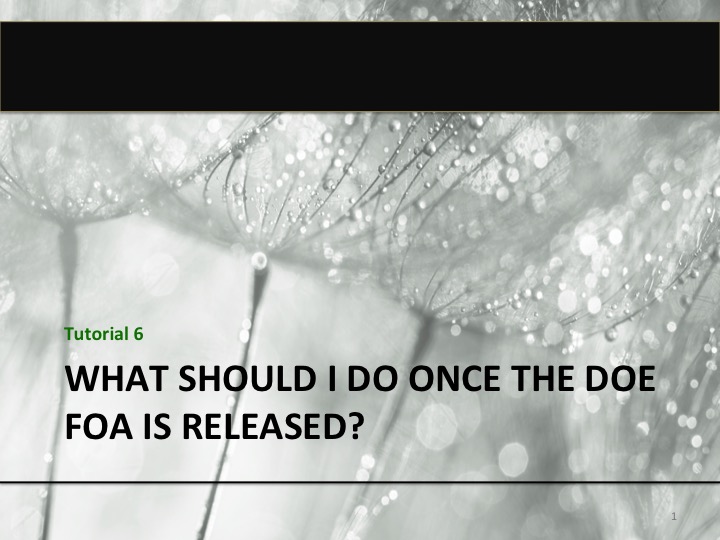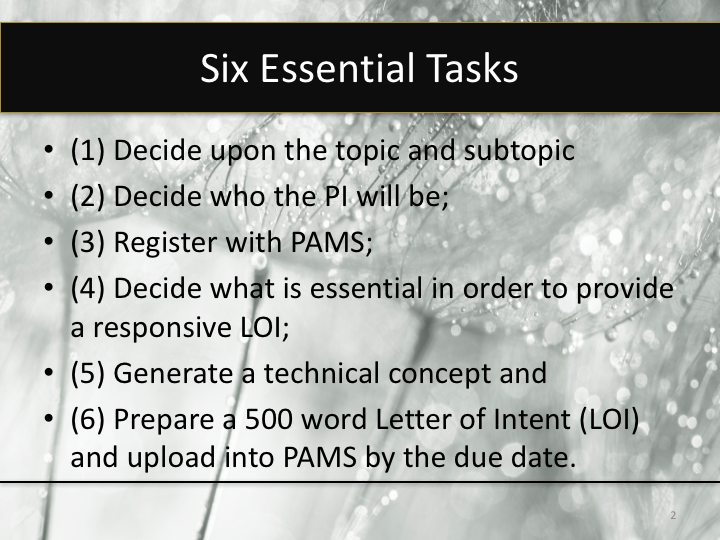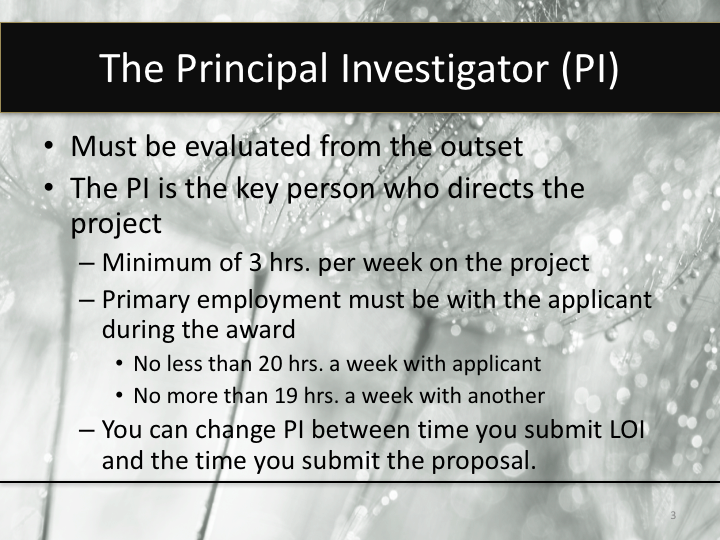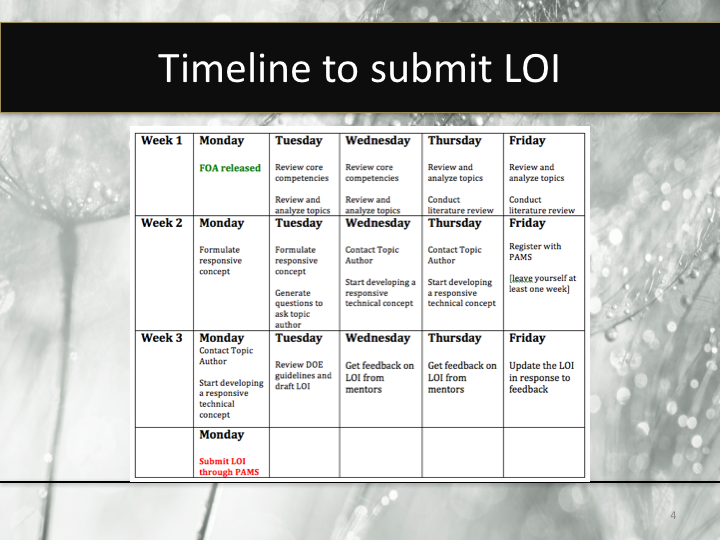Tutorial 6:
Timeline for proposal Preparation
Successful proposal preparation requires planning. As soon as the DOE Funding Opportunity Announcement (FOA) is released begin to map out a schedule of critical tasks. A template is provided in the Tools section of this Tutorial to assist you. Divide your time between those activities that require your creativity and those that that are mundane and require perseverance. Set aside unfettered time to address creative tasks and also time to tackle application processes and financial considerations.
The Department of Energy proposal preparation process is unique in as much as potential applicants must submit a Letter of Intent (LOI) just three weeks after the FOA is released. If you do not submit the LOI, you will NOT be eligible to submit a proposal. Therefore, the LOI is an important task and one that will require both your creativity and your perseverance.
So what should you do between the time the DOE Funding Opportunity Announcement (FOA) is released and the due date for the obligatory Letter of Intent (LOI)? There are six essential tasks – some of which will require your creativity and self-reflection while others with require persistence.
Although six tasks are listed – do not view this as an overwhelming activity – it is NOT. For you the LOI provides the opportunity to reflect upon your core competencies, review DOE’s needs – and decide if and how you can bring those together. For DOE, the LOI provides the Agency with the opportunity to select the best reviewers for your proposal and to let you know if your concept appears to be non- responsive to DOE’s needs – before you spend a lot of time writing a proposal. DOE will only let you know if the LOI appears to not be responsive to what’s sought in the subtopic – otherwise you can consider your concept acceptable for submission to the FOA.
Each of the six tasks are discussed below.
- 1) Decide upon the topic and subtopic for which you will prepare a proposal;
Per the guidelines provided in the FOA, an applicant can hypothetically submit up to 10 LOIs – but for sake of this discussion we assume you will submit just one. The topics and subtopics you can choose from are found in the Topics document on DOE’s SBIR/STTR FOA web site. Scan the list of topics in the table of contents and as you do, consider your core competencies. Sometimes companies scan the list and say “Oh my – this is not my area of expertise”; while others will say “I can do that – I have strengths in XYZ.” Start there – start by articulating your core competencies. If key words come to mind in this exercise such as “nanofabrication, natural gas, 3D printing, CFD” – conduct a key word search of the Topics document using those terms to see where they arise. This will help you focus on subtopic opportunities.
When you submit your LOI you must identify both the topic and subtopic to which you will respond. Be sure to read both in great detail – so that you understand DOE’s specific interests and later can prepare a responsive LOI. Set aside a few unfettered hours ASAP to review the topics – we recommend that you do this when you may have a few hours of uninterrupted time – perhaps evenings or week-ends.
- 2) Decide who the Principal Investigator (PI) will be
The Principal Investigator (PI) is a big deal. You must identify the PI not only in the LOI – but beforehand when you register on line with PAMS – e.g. the system through which your LOI must eventually be submitted. Some key points to keep in mind when thinking about who the PI should be: (1) There may only be ONE PI – no co-PIs are allowed. (2) The Principal Investigator is the key person who directs the project. He or she must spend a minimum of 3 hours per week for the duration of the SBIR or STTR Phase I project. (3) At the time of award and during the conduct of the award, the PI’s primary employment must be with the applicant. Primary employment means that no less than 20 hours per week is spent in the employment of the applicant during the conduct of the project and no more than 19 hours per week spent in the employment of another organization. Please note that you CAN change the PI between the time you submit the LOI and the time you submit the proposal.
When starting a company the PI guidelines often create a dilemma regarding when to start a firm – how does one address this challenge? The answer in part lies in the fact that the PI’s primary employment is determined when the award is made and not at the time an LOI or application is submitted.
- 3) Register with PAMS – the DOE Office of Science Portfolio Analysis System, (PAMS); and ensure that you’re SAM – System for Award Management and Grants.gov registrations are valid, and if not renewed.
Make sure that you register with PAMS as early as possible as this is the source through which you must submit your LOI. The Department of Energy recommends that you register with PAMS at least one week before the LOI due date. This is an excellent recommendation.
https://pamspublic.science.energy.gov/webpamsepsexternal/login.aspx
Please note that there may be a cautionary statement at the top of the log-in page for Mac users. If you are a Mac user (as we are), we would highly recommend that you use someone’s PC to register and upload documents to this site. It will save you hours of aggravation to simply use a pc. In fact, we keep a lap-top PC available strictly for government registrations. If you don’t have a pc available – use a friends or go to a FedEx/Kinko store. If you find application and registration processes frustrating, consider going through this process with a colleague or if you have administrative support, ask your admin to work with you.
Additionally, there are several one-time actions you must complete in order to submit an application in response to the FOA (e.g., obtain a Dun and Bradstreet Data Universal Numbering System (DUNS) number, register with the System for Award Management (SAM), and register with Grants.gov). Those applicants not registered with SAM and/or Grants.gov must understand that it may take up to 6 weeks to complete these requirements. It is suggested that you begin these registration processes immediately.
- 4) Decide what is essential in order to provide a responsive LOI
This is where your creativity comes into play. Your LOI must be responsive to DOE’s objectives. Therefore, it is important that you don’t try to force your interests into a category, if it doesn’t fit. Your goal is to apply your core competency to solve a DOE stated problem. Review the topic(s) you down-selected earlier – and highlight in the document what must be covered in your response in order to be responsive. Look for any performance metrics within the subtopic – as you must be able to address these. Ask yourself if you truly do have a way to address the interests that DOE has articulated in its topics and subtopics?
- 5) Generate a technical concept that addresses the topic
Now that you have reflected upon your core competencies and determined what is essential in order to submit a responsive technical concept – it is time to determine what you will propose. How will you bring together your core competencies and DOE’s needs? What innovation can you bring to the table? To address this challenge, you will need unfettered time – perhaps time with a colleague or an advisor to brainstorm or gather feedback to ideas you have generated. Once you have a good concept, you can begin to work on the Letter of Intent.
- 6) Prepare a 500 word Letter of Intent
For some writing comes easily, while for others writing is a difficult task. Let’s take a look at what you are being asked to do in preparing the LOI. First, don’t be confused by the fact that this is called a “Letter” – this is NOT a letter of transmittal. This is a not-to-exceed 500 word document that could take up to two pages if you include figures or tables. For you the purpose of the document is to provide a technical description of your proposed technology solution to a DOE specified problem area. For DOE, it is an opportunity to find relevant reviewers for anticipated Phase I proposals. Be sure to see the example that DOE has provided on its web site before you begin.
An analysis of the sample LOI shows that it contains the following elements.
- Clarification of the type of Product/Technology to be developed and the particular field of application
- Anticipated results with value proposition/advantage/benefit to customers described relative to existing products
- DOE Objective in the specific Topic/subtopic for this LOI
- Description of the company’s approach or concept and particularly a novel technical component to be included in the proposal
- Briefly describe the risk that must be resolved before you know if your innovation is feasible
- List of 2-3 technical development tasks that PI will carry out in phase I to validate the results
- An indication as to who will be performing the work at what locations, noting any collaborators, and accentuating your team’s qualifications
When you start to prepare the written document, initially don’t worry about the number of words, just try to capture the information. Now is the time to be comprehensive. Attempt to address each of the elements listed above and discuss the concept with a colleague. Then begin to pare down the number of words so that you create a compelling and responsive 500 word or less document. Arrange the concepts in a sequence which best explains the relevance of what you propose and which will make it easy for DOE to determine who they should involve as reviewers. If you are working with a consultant on the preparation of the LOI – make sure that you provide them sufficient time to review the document and provide you with feedback.
With any submission, it’s good practice to always prepare to submit a proposal the day before it is due. When you are ready to submit the document, go back to PAMS and follow the upload guidelines which DOE has provides in its FOA.
Timeline
Preparing a responsive LOI is a great way to start the proposal preparation process. Developing the LOI will force you not only to look closely at the topics, but to evaluate your core competencies, and develop a concept that you will flesh out in the balance of the proposal preparation process. The following is an idealized schedule for developing a responsive LOI. This schedule can of course be condensed – but it provides a sequential guide for developing a responsive Letter of Intent.
Once you have submitted your LOI continue with the subsequent stages of the proposal preparation process. If you have been successful in developing a responsive LOI you will not receive any feedback from DOE. If your LOI appears to NOT responsive to the topics/subtopics DOE will let you know within three weeks. You will still be able to submit a proposal even if you are advised that your initial LOI appears non-responsive, but please be sure to follow up with the Topic Manager as noted in Tutorial 5.
Quiz: Tutorial 6: Timeline: What should I do once the DOE FOA is released?
1
What is the maximum number of Letters of Intent one can submit in response to an FOA?
Nice Work
Try Again
2
Which of the following is NOT a true statement?
Nice Work
Try Again
3
Which of the following is true? A Letter of Intent (LOI)…
Nice Work
Try Again
4
How many weeks are there between the release of the FOA and the LOI due date?
Nice Work
Try Again
5
Which site do you use to submit the LOI?
Nice Work
Try Again



